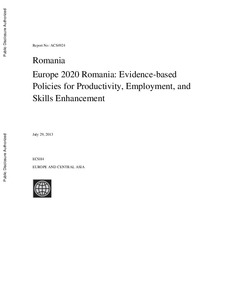Europe 2020 Romania : evidence-based policies for productivity, employment, and skills enhancement
"Employment and skills are at the core of Europe 2020, the European Union's (EU) competitiveness strategy, and are decisive for high productivity and sustained growth. Romania has overcome significant challenges on its path to EU membership and in the early years thereafter. However, the R...
| Institution: | ETUI-European Trade Union Institute |
|---|---|
| Format: | TEXT |
| Language: | English |
| Published: |
Washington, DC
2013
World Bank |
| Subjects: | |
| Online Access: | https://www.labourline.org/KENTIKA-19124675124919428579-europe-2020-Romania-evidence-b.htm |
| Summary: | "Employment and skills are at the core of Europe 2020, the European Union's (EU) competitiveness strategy, and are decisive for high productivity and sustained growth. Romania has overcome significant challenges on its path to EU membership and in the early years thereafter. However, the Romanian economy has recently come under pressure as a result of the economic crisis and because important reforms in employment and education have not yet been completed. The Europe 2020 Romania report discusses the key challenges currently faced by Romania in the area of productive employment, and proposes a set of steps the Romanian government could consider in order to reach the Europe 2020 targets. Skills remain a major challenge. In particular, there is insufficient provision of the higher level generic and technical skills needed for a modern and competitive economy, including skills for technological innovation and absorption of new technologies. While Romania performs comparatively well in terms of higher education participation rates, there are concerns about early school leavers and the quality of provision, in particular at the tertiary level but also at earlier stages. Skills shortages are a major constraint to economic growth, together with labor participation. For Romania to achieve its Europe 2020 employment target it must increase employment rates, starting with the labor force participation of women, youth and older workers. Achieving the Europe 2020 employment target in Romania thus hinges especially on increasing the labor force participation of the population beyond the age of 55, especially of women. Romania could expand its labor force by at least 25 percent if older workers fulfilled their participation potential. This report argues that by combining policies in two key areas, Romania can achieve its Europe 2020 employment target and go beyond that. The most relevant policy factors under the two pillars: 1) in the short and medium term, policy reforms to enable a faster dynamic of job creation by the private sector; and 2) in the short to longer term, policies to foster the adaptability and productivity of a shrinking and aging workforce." |
|---|---|
| Physical Description: | 120 p. Digital |

